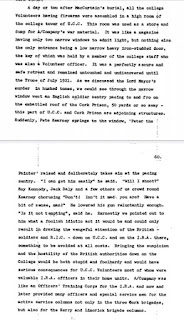Constable Frederick Sterland was spending a Sunday afternoon drinking in Cork City. The 28 year old from Birmingham was off duty but, he was a marked man. Commandant Michael Murphy, 2nd Battalion Cork No.1 Brigade, described Sterland as "an able intelligence man brought over from England specially as a secret service agent for the British."
Sterland had been in Ireland for four months before the Cork Brigade got their man on a sunny Spring Sunday in 1921. In the weeks leading up to Sterlands death he was closely watched by members of D Company who befriended him in the pubs he frequented across the city. On the afternoon of his death he began his drinking at Desmond's Hotel on Pembroke Street where he met members of D Company. After a few jars they decided to go to the Rob Roy Hotel on Cook Street.
While Sterland and his 'drinking buddies' went to the lounge upstairs at the Rob Roy, volunteers gathered in the junction of South Mall and Cook Street. One of the volunteers entered the Rob Roy and closed the door in the hallway leading out to the street. The proprietor Mr Evans noticed the IRA activity and protested against it but then a small number of British Soldiers arrived on Cook Street and knocked on the door to see if it was open. Mr Evans was instructed at gunpoint by the volunteer to tell them to come back in an hour as there was a cleaning job going on! Amazingly the soldiers agreed and went off towards St Patrick Street.
(The Rob Roy on Cook Street, no longer a hotel but still serving pints!)
Sterland heard the commotion downstairs and left the lounge to see what was going on. As he walked down stairs he was ordered to put his hands up by the IRA volunteers who followed behind him. Sterland was marched forward and as the door was opened he was shot.
After the shots rang out, the Volunteers then rushed up Cook Street towards South Mall where they sped off in a car in the direction of Greenmount.




















































